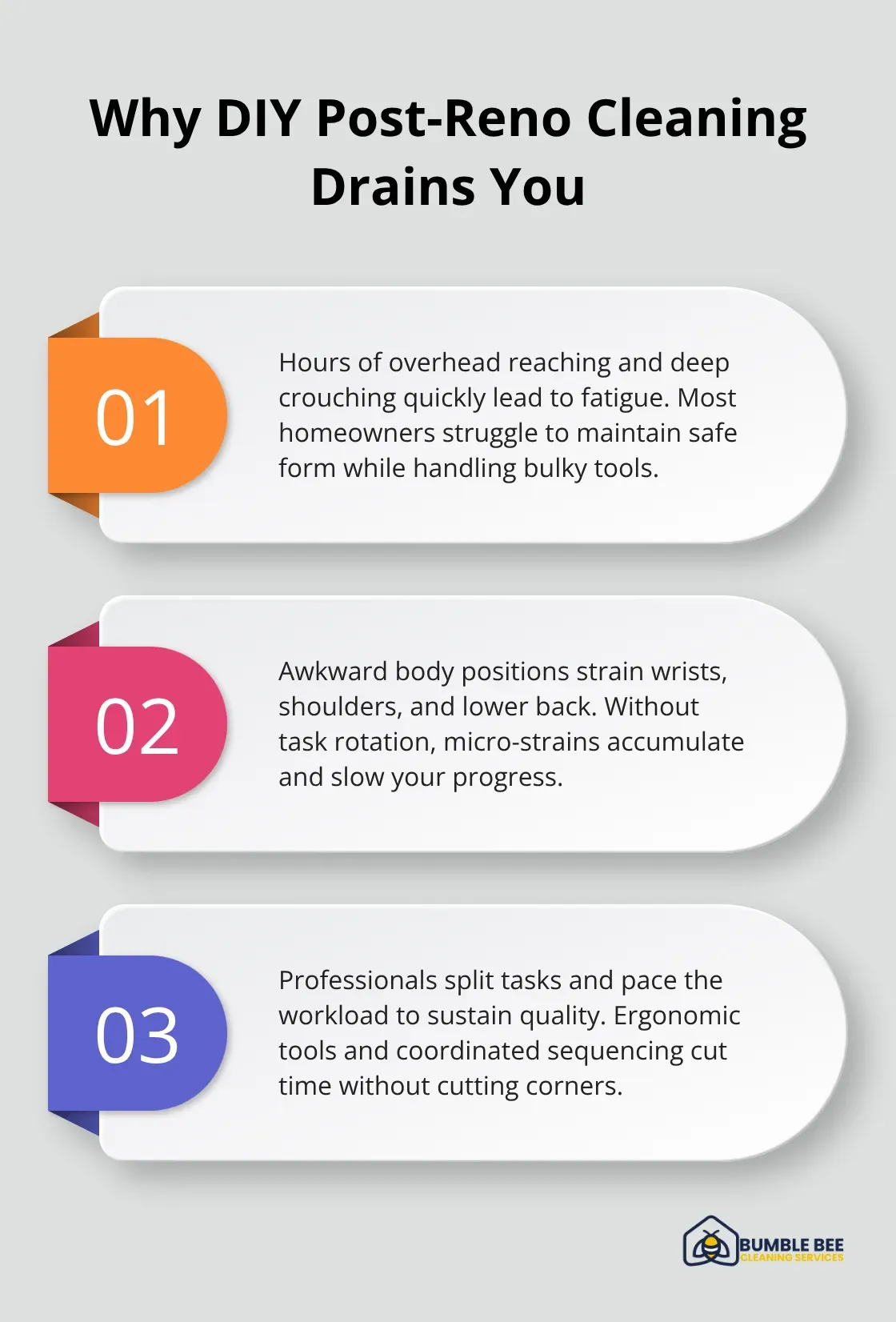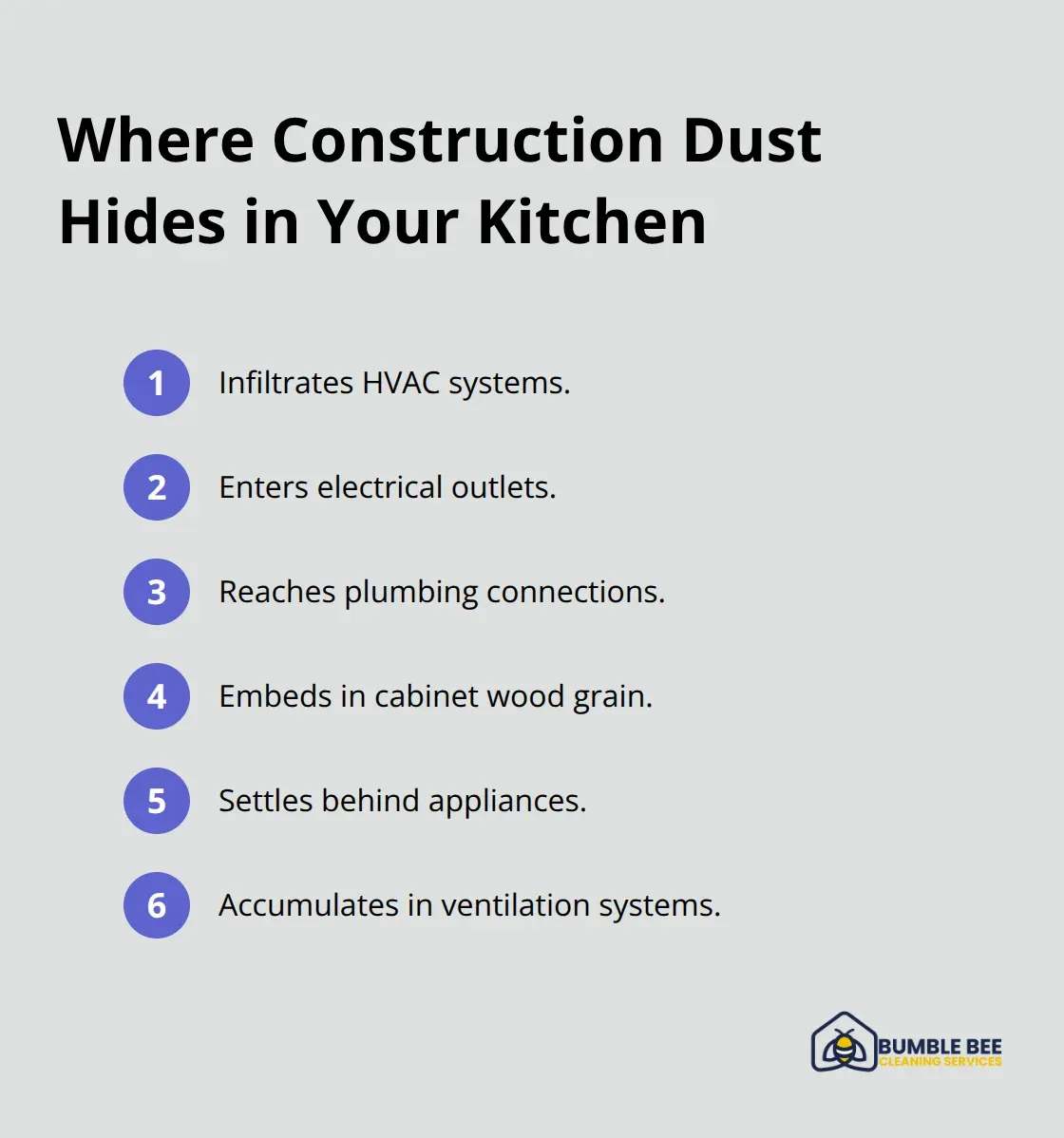Your kitchen renovation looks amazing, but construction dust and debris have settled everywhere. Professional cleaning removes hidden contaminants that regular household products can’t handle.
We at Bumble Bee Cleaning Services see homeowners struggle with post-renovation cleanup daily. The right approach protects your investment and gets you cooking safely again.
Post-Renovation Kitchen Cleaning Essentials
Construction dust finds its way into places you never expect. You may consider having your air ducts cleaned simply because it seems logical that air ducts will get dirty over time and should be occasionally cleaned. Professional-grade HEPA filters capture 99.97% of particles as small as 0.3 microns, while standard household vacuums push fine dust around instead of trapping it. Start with ceiling fixtures and work down to baseboards, cleaning light switches, outlet covers, and window sills where dust builds up heavily.
Remove Construction Dust and Debris from All Surfaces
Your kitchen surfaces harbor microscopic particles that standard cleaning tools cannot reach. Professional post-construction cleaning typically requires 20-30 hours in a 2,000 square foot home because thorough dust removal demands systematic attention to every surface. Countertops, backsplashes, and cabinet faces need specialized cleaning products that break down construction adhesive residue without damaging new finishes. Residents should be alert to signs of inadequate ventilation, such as stuffy air, moisture condensation on cold surfaces, or mold and mildew growth.
Deep Clean Appliances Inside and Out
Refrigerator coils, oven vents, and dishwasher filters trap construction particles that regular maintenance misses. Appliances require complete disassembly for proper decontamination because dust penetrates internal mechanisms and can cause premature failure. Microwave interiors, range hood filters, and garbage disposal components need specialized products to remove adhesive residue from protective films.

The Institute of Inspection Cleaning and Restoration Certification emphasizes that construction dust in appliance systems can void warranties if not properly addressed.
Sanitize Countertops and Cabinet Interiors
Cabinet interiors collect sawdust, paint particles, and adhesive fumes that contaminate food storage areas. Professional cleaning services (ranging from $0.10 to $0.50 per square foot) eliminate health risks from volatile organic compounds that persist for months. Activated charcoal absorbs chemical odors naturally, while specialized degreasers remove construction adhesive from cabinet hardware. Food safety standards require complete sanitization before you store dishes or ingredients in these spaces.
Now that you understand what surfaces need attention, the next question becomes whether to tackle this massive job yourself or hire professionals who have the right tools and experience.
Professional Kitchen Cleaning vs DIY Approach
Most homeowners underestimate the physical toll of post-renovation cleanup. You’ll spend considerable time scrubbing surfaces in awkward positions, climbing ladders to reach ceiling fixtures, and breathing construction dust despite masks. Your back will ache from crouching to clean baseboards, and your arms will burn from overhead scrubbing. Professional cleaners complete the same work in half the time because they deploy teams that work simultaneously and use proper ergonomic techniques.
Time Investment and Physical Demands of Self-Cleaning
Post-renovation cleanup demands intensive physical labor that exhausts most homeowners within hours. You must maintain awkward positions for extended periods, reach overhead repeatedly, and handle heavy equipment while wearing protective gear. The repetitive motions strain muscles and joints, particularly when you clean textured surfaces that require aggressive scrubbing.

Professional teams rotate tasks to prevent fatigue and maintain consistent quality throughout the process.
Specialized Equipment and Products Needed for Thorough Results
Standard household tools fail against construction debris. You need industrial-grade HEPA vacuums ($300-800), specialized degreasers for adhesive residue ($25-40 per bottle), and microfiber cloths designed for fine particle capture. Most homeowners lack the $1,200-2,000 equipment investment required for thorough results. Professional services arrive with commercial-grade air scrubbers, dust containment systems, and specialized brushes that remove particles from textured surfaces. The Institute of Inspection Cleaning and Restoration Certification confirms that consumer-grade equipment removes only surface-level contamination.
Cost Analysis of Professional Services vs Personal Time and Materials
Professional post-construction cleaning costs $475 for average kitchens, while DIY approaches seem cheaper until you factor in equipment rental, specialized products, and your time value. Equipment rental costs $150-250 daily, quality products add another $100-200, and most homeowners need multiple attempts to achieve professional results. Calculate your hourly wage against 30 hours of intensive labor, and professional services become financially sensible.
The physical demands and equipment requirements represent just part of the challenge. Health risks from construction residue create even more serious concerns that require professional expertise.
Health and Safety Considerations After Kitchen Renovation
Construction dust contains silica particles that cause respiratory irritation and long-term lung damage when you inhale them regularly. The Environmental Protection Agency reports indoor air pollution reaches 2-5 times higher than outdoor levels after renovation, which makes immediate professional intervention necessary rather than optional. Prolonged exposure to construction dust triggers asthma attacks, chronic cough, and breathing difficulties that worsen without proper removal techniques. Standard household cleaning stirs particles back into the air instead of capturing them, which explains why many homeowners experience persistent respiratory symptoms weeks after renovation completion.
Construction Dust Penetrates Deep Into Kitchen Systems
Fine construction particles infiltrate HVAC systems, electrical outlets, and plumbing connections where they continue to circulate contaminated air throughout your home. The National Air Duct Cleaners Association recommends immediate duct cleaning after major renovations because standard filters cannot capture particles smaller than 0.3 microns. These particles embed in cabinet wood grain, settle behind appliances, and accumulate in ventilation systems where they release toxins for months.

Professional removal requires negative air pressure systems and HEPA filtration that costs $300-500 but prevents thousands in medical bills from respiratory complications.
Volatile Organic Compounds Contaminate Food Preparation Areas
New paint, adhesives, and building materials release formaldehyde, benzene, and other volatile organic compounds that contaminate surfaces where you prepare food. These chemicals can cause eye, nose and throat irritation, headaches and dizziness with short-term exposure, while prolonged exposure to high levels may lead to more serious health effects. Professional-grade sealers and specialized cleaning agents neutralize these compounds before they penetrate food contact surfaces. Baking soda and activated charcoal provide temporary odor relief but cannot eliminate the chemical residues that require enzymatic cleaners and proper ventilation systems to remove completely.
Food Safety Requires Complete Surface Decontamination
Construction residue creates bacterial breeding grounds that standard sanitizers cannot penetrate, which makes thorough decontamination essential before food storage or preparation begins. Sawdust and drywall particles harbor pathogens that multiply rapidly in kitchen humidity, while adhesive residues prevent proper sanitization of food contact surfaces. Professional cleaning protocols include antimicrobial treatments that eliminate both visible contamination and microscopic threats that cause foodborne illness. Home sanitizers lack the concentration needed to neutralize construction-related contaminants, which explains why many families experience digestive issues after they move back into renovated kitchens too quickly.
Final Thoughts
Professional post-renovation kitchen cleaning removes health risks that DIY methods cannot address. Construction dust contains silica particles and volatile organic compounds that require specialized equipment and expertise to remove completely. The $475 investment in professional services prevents respiratory complications and protects your kitchen renovation investment.
We at Bumble Bee Cleaning Services use HEPA filtration systems and eco-friendly products to restore your kitchen to food-safe conditions. Our team removes microscopic contaminants that standard tools miss, which allows you to cook safely within days instead of weeks. Replace HVAC filters monthly and wipe surfaces with microfiber cloths (they trap particles more effectively than cotton rags).
Your kitchen renovation deserves professional attention to detail. Bumble Bee Cleaning Services provides comprehensive post-construction cleanup that transforms your construction zone into a pristine space. Schedule quarterly deep maintenance to prevent dust accumulation in cabinet interiors and appliance vents where particles settle over time.
